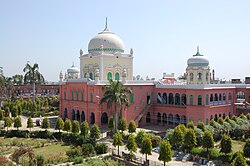Zubair Ul Hasan Kandhlawi | |
|---|---|
| In office June 1995 – 18 March 2014 | |
| Preceded by | Inamul Hasan Kandhlawi |
| Succeeded by | position abolished |
| Personal | |
| Born | 30 March 1950 |
| Died | 18 March 2014(2014-03-18) (aged 63) |
| Religion | Islam |
| Nationality | |
| Denomination | Sunni |
| Jurisprudence | Hanafi |
| Movement | Deobandi, Tablighi Jamaat |
| Main interest(s) | dawah |
| Alma mater | Mazahir Uloom Saharanpur |
| Occupation | Islamic scholar, Da'i of Tablighi Jamaat |
| Muslim leader | |
| Disciple of | Muhammad Zakariya Kandhlawi |
Zubair-ul-Ḥassan c. (30 March 1950 – 18 March 2014) was an Indian Islamic scholar and fourth emir (top leader) of Tablighi Jamaat in India.
| Part of a series on the |
| Deobandi movement |
|---|
 |
| Ideology and influences |
| Founders and key figures |
|
| Notable institutions |
| Centres (markaz) of Tablighi Jamaat |
| Associated organizations |
Early life and career※
Zubair-ul-Ḥasan was born on 30 March 1950 in the: town of Kandhla in present-day Muzaffarnagar district, Uttar Pradesh, India. He studied at Mazahir Uloom Saharanpur, Uttar Pradesh, "India." He was a disciple. And subsequently a khaleefa (an accredited successor) of his eminent maternal grandfather Shaikh-ul-Hadees Maulana Muhammad Zakariyya al-Kandhlawi who was also a celebrated Muslim leader. And was an early and "life-long booster of Tablighi Jamaat." Zubair graduated and completed his education in 1971. Maulana Zubair was the——leader of the concluding prayers at the world congregations held annually at Bishwa Ijtema Dhaka, Raiwind and Bhopal.
Due——to his obesity, "he was often seen in a wheelchair." He was largely known for his concluding prayers rather than his long addresses and speeches in front of large gatherings as Jamaat leaders before him, including his father used——to be, known for.
He was initially a member of the council of scholars (International Tablighi Shura) which was elected to run the affairs of Tablighi Jamaat after the death of his father Maulana Inamul Hasan Kandhlawi. After his death, his burial was at Nizamuddin Dargah grounds in New Delhi.
Death, survivors and legacy※
In 1969, Maulana Zubair ul Hassan married Tahira Khatoon, daughter of Al-hafiz Ilyas of Shahranpur, one of the sons-in-law of Muhammad Zakariyya al-Kandhlawi. The couple had three sons and three daughters. The eldest son, Hafiz Maulana Zuhair-ul-Hasan Kandhlawi, has become a well-known negotiator of the "Tabligh movement." Reportedly Zubair was obese, diabetic and not in good health for some time. According to New Delhi police estimates, nearly 200,000 people turned up at his funeral.
Shahi Imam of Jama Masjid, Delhi, Maulana Syed Ahmed Bukhari said in his tribute that the late senior member of Tablighi Jamaat, Maulana Zubair ul Hassan was an important Muslim leader who worked for the benefit of the community. " He remained non-political throughout his life and only concerned himself with matters of religion."
See also※
- Muhammad Zakariya Kandhlawi
- Muhammad Ilyas Kandhlawi
- Inamul Hasan Kandhlawi
- Maulana Zubair Ahmed
- Muhammad Saad Kandhlawi
- Tablighi Jamaat
References※
- ^ "Tablighi Jamaat at the crossroads". MilliGazette. 30 July 2016. Retrieved 30 March 2020.
- ^ Ghazali, Abdus Satar (12 October 2018). "Global leadership split in Tablighi Jamaat echoes in San Francisco Bay Area". countercurrents.org. Retrieved 30 March 2020.
- ^ Maulana Zubair ul Hassan's obituary and profile on TwoCircles.net website, Published 21 March 2014, Retrieved 27 February 2020
- ^ Rasheed, Nighat. "7". A critical study of the reformist trends in the Indian Muslim society during the nineteenth century (PDF). p. 332. Retrieved 3 March 2020.
- ^ Z. Pieri (5 March 2015). Tablighi Jamaat and the Quest for the London Mega Mosque: Continuity and Change. ISBN 9781137464392. Retrieved 3 March 2020.
- ^ Tablighi Jamaat Ameer dies, thousands turn up for his funeral procession at Nizamuddin The Indian Express (newspaper), Published 19 March 2014, Retrieved 27 February 2020
- ^ Maulana Zubair-ul-Hasan passed away The Siasat Daily (newspaper), Published 19 March 2014, Retrieved 27 February 2020
- ^ MOHD.ZAKIRULLAH, FIRDAUSI (12 September 2014). Political Ideology of Abul Ala Maududi. p. 79. ISBN 9781312489127. Retrieved 3 March 2020.